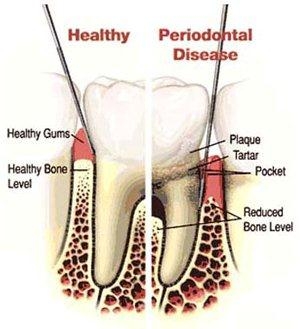Hygiene
Hygiene
After assessing a patient's individual oral health condition and incorporating the most current scientific research, including consideration of the impact of oral health on diseases such as heart disease and diabetes, our dentist and dental hygiene will plan a specific treatment plan designed to make sure each patient has the best oral health possible.
Additional
Hygienist information can be found at Webmd.com.
Prophylaxis
A routine dental adult cleaning or prophylaxis is a procedure that involves the cleaning of your teeth from primarily your gums and up. It may involve all hand scaling or a combination of hand scaling and ultrasonic scaling followed by a polishing with a fine paste.
Periodontal Maintenance
Sometimes a patient will have a lot of buildup around the teeth, so much so that the doctor or hygienist cannot reach a proper diagnosis with out first removing the bulk of the buildup on the teeth and reduce its associated bleeding. This type of cleaning is called a periodontal scaling or gross scaling.
When a patient has been through scaling and root plannings due to the presence of periodontal disease, he/she is placed on a more frequent recall interval - usually at 3 months apart. These types of cleanings are termed "periodontal maintenance" appointments and are vital to the success of treating the periodontal disease. Once you have periodontal disease you are more prone to relapse back into a diseased state. Meticulous home care is absolutely essential followed by strict adherence to your professional maintenance visits. These visits are more involved than a routine prophy appointment. The pocket depth that need to be maintained are greater and present a more challenging job for the hygienists. Also, these deeper pockets may need some spot root scaling and irrigation.
Periodontal Disease

Bacteria in your mouth forms a sticky film (plaque) on teeth and gums. If not removed, this hardens into a crust (tartar). The bacteria in plaque and tartar can cause an infection called periodontal disease. This can lead to pain, gum damage, bone loss and even tooth loss. Scaling and root planning is a special type of cleaning done by a general dentist, dental hygienist, or periodontist (a dentist specializing in gum and bone problems). This cleaning removes plaque and tartar from beneath the gums. This helps restore health to your gums and teeth.
Non-Surgical Gum Treatments
The gums, ligaments, and bone around the teeth form the foundation for ones teeth. All structures are also referred to as the periodontium. When the periodontium is not healthy, it jeopardizes the teeth just as a bad foundation would threaten the stability of a house. Signs of unhealthy periodontium (gum disease) may be as follows: gums that are red and bleed easily, persistent bad breath, gums that are pulled away from the tooth, loose teeth, and changes in the position or bite of the teeth. Any of these signs may mean something is wrong. With proper care, however, it may be possible to return teeth to a healthy, stabilized state. This is where appropriate gum treatments come in. If your having a problem, come in and see us so we can take care of it right away. The treatment usually involves a deep cleaning or root planning done under a local anesthetic, along with local antibiotic agents. If the gum disease gets too severe it may need to be treated through surgery or extraction. This is why it is important to seek treatment at the first sign of a problem.
Scaling and Root Planning
The dentist looks at your gums for color changes, bleeding, swelling, recession. Your teeth are checked for looseness and sensitivity. Full mouth x-rays show if there is bone loss around your teeth. You may be asked about your health to see if a medical condition, like diabetes, is contributing to your periodontal disease.
Periodontal Probing helps measure how advanced your disease is. During probing, a tool (probe) measures the depth of the space (called a pocket) between the tooth and the surrounding gum. The deeper the pocket, the more severe the problem.
Scaling and root planning removes plaque and tartar from below your gum line. This controls the growth of harmful bacteria. It also helps gums reattach firmly to teeth. Because this procedure goes deeper than regular cleaning, your mouth may be numbed. This cleaning may take 1 to 4 or more visits to complete.